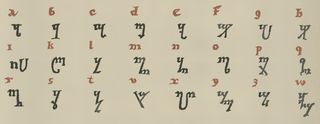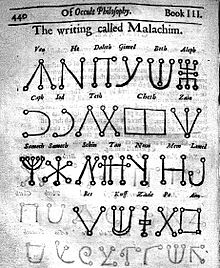
Gematria is the practice of assigning a numerical value to a name, word or phrase by reading it as a number, or sometimes by using an alphanumerical cipher. The letters of the alphabets involved have standard numerical values, but a word can yield several values if a cipher is used.

Numerology is the belief in an occult, divine or mystical relationship between a number and one or more coinciding events. It is also the study of the numerical value, via an alphanumeric system, of the letters in words and names. When numerology is applied to a person's name, it is a form of onomancy. It is often associated with astrology and other divinatory arts.

Heinrich Cornelius Agrippa von Nettesheim was a German Renaissance polymath, physician, legal scholar, soldier, knight, theologian, and occult writer. Agrippa's Three Books of Occult Philosophy published in 1533 drew heavily upon Kabbalah, Hermeticism, and neo-Platonism. His book was widely influential among esotericists of the early modern period, and was condemned as heretical by the inquisitor of Cologne.
The Lesser Key of Solomon, also known as Lemegeton Clavicula Salomonis or simply Lemegeton, is an anonymously authored grimoire on sorcery. It was compiled in the mid-17th century, mostly from materials several centuries older. It is divided into five books: the Ars Goetia, Ars Theurgia-Goetia, Ars Paulina, Ars Almadel, and Ars Notoria. It is based on the Testament of Solomon and the ring mentioned within it that he used to seal demons.

There have been various attempts at the classification of demons within the contexts of classical mythology, demonology, occultism, and Renaissance magic. These classifications may be for purposes of traditional medicine, exorcisms, ceremonial magic, witch-hunts, lessons in morality, folklore, religious ritual, or combinations thereof. Classifications might be according to astrological connections, elemental forms, noble titles, or parallels to the angelic hierarchy; or by association with particular sins, diseases, and other calamities; or by what angel or saint opposes them.

Johannes Trithemius, born Johann Heidenberg, was a German Benedictine abbot and a polymath who was active in the German Renaissance as a lexicographer, chronicler, cryptographer, and occultist. He is considered the founder of modern cryptography and steganography, as well as the founder of bibliography and literary studies as branches of knowledge. He had considerable influence on the development of early modern and modern occultism. His students included Heinrich Cornelius Agrippa and Paracelsus.

Three Books of Occult Philosophy is Heinrich Cornelius Agrippa's study of occult philosophy, acknowledged as a significant contribution to the Renaissance philosophical discussion concerning the powers of magic, and its relationship with religion. The first book was printed in 1531 in Paris, Cologne, and Antwerp, while the full three volumes first appeared in Cologne in 1533.
A constructed writing system or a neography is a writing system specifically created by an individual or group, rather than having evolved as part of a language or culture like a natural script. Some are designed for use with constructed languages, although several of them are used in linguistic experimentation or for other more practical ends in existing languages. Prominent examples of constructed scripts include Korean Hangul and Tengwar.
The Sworn Book of Honorius is a medieval grimoire purportedly written by Honorius of Thebes. The Latin word juratus, which is typically translated "sworn", is intended to mean "oathbound". It was allegedly the grimoire of Pope Honorius I, hence its name.

The pigpen cipher is a geometric simple substitution cipher, which exchanges letters for symbols which are fragments of a grid. The example key shows one way the letters can be assigned to the grid.

The Theban alphabet, also known as the witches' alphabet, is a writing system, specifically a substitution cipher of the Latin script, that was used by early modern occultists and is popular in the Wicca movement.

The Celestial Alphabet, also known as Angelic Script, is a set of characters described by Heinrich Cornelius Agrippa in the 16th century. It is not to be confused with John Dee and Edward Kelley's Enochian alphabet, which is also sometimes called the Celestial alphabet. Other alphabets with a similar origin are Transitus Fluvii and Malachim.
Alphabet of the Magi is the modern name of a variant of the Hebrew alphabet used for inscriptions in talismans in 17th-century occultism.

The angel Jophiel, also called Iophiel, Iofiel, Jofiel, Yofiel, Youfiel, Zophiel and Zuriel, is an archangel in Christian and Jewish angelology. Jophiel is associated with beauty, art, and wisdom.

Divine language, the language of the gods, or, in monotheism, the language of God, is the concept of a mystical or divine proto-language, which predates and supersedes human speech.
Malach or Malakh may refer to:
Shem HaMephorash, meaning "the explicit name," is originally a Tannaitic term describing the Tetragrammaton. In Kabbalah, it may refer to a name of God composed of either 4, 12, 22, 42, or 72 letters, the latter version being the most common.

Transitus Fluvii or Passage Du Fleuve is an occult alphabet consisting of 22 characters described by Heinrich Cornelius Agrippa in his Third Book of Occult Philosophy. It is derived from the Hebrew alphabet and is similar to the Celestial and Malachim alphabets. The name may refer to the crossing of the Euphrates by the Jews on their return from the Babylonian captivity to rebuild the Temple in Jerusalem.
English Qaballa (EQ) is a system of Hermetic Qabalah, supported by a system of arithmancy that interprets the letters of the English alphabet via an assigned set of values, discovered by James Lees in 1976. It is the result of an intent to understand, interpret, and elaborate on the mysteries of Aleister Crowley's received text, Liber AL vel Legis, the Book of the Law. According to Jake Stratton-Kent, "the English Qaballa is a qabalah and not a system of numerology. A qabalah is specifically related to three factors: one, a language; two, a 'holy' text or texts; three, mathematical laws at work in these two."
A magical alphabet, or magickal alphabet, is a set of letters used primarily in ceremonial magic ('magick'), occult practices, and esoteric traditions. These alphabets serve various purposes, including encoding secret messages, conducting rituals, creating amulets or talismans, casting spells, and invoking spiritual entities. Several magical alphabets, including the Celestial Alphabet, Malachim, and Transitus Fluvii, are based on the Hebrew alphabet, which itself has a long history of use in mystical and magical contexts.

































